
Second innings: Sachin Tendulkar gets into his stride
Leveraging on his personal values as a cricketer, the master blaster continues to flourish as a covetable brand five years after his retirement
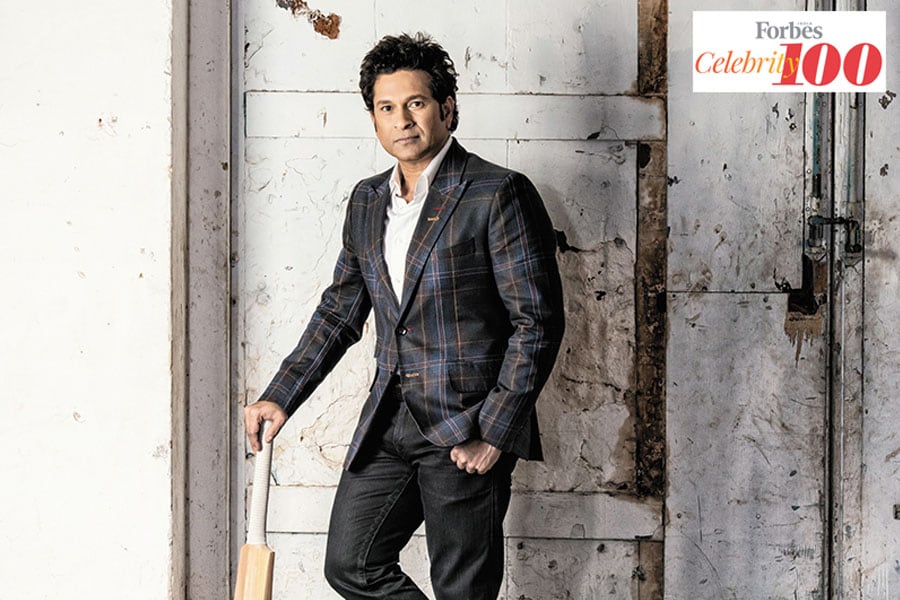 Forbes India Celebrity 100 Rank No. 9; Wardrobe: True Blue; Makeup Artist: Vipul Bhagat; Hair: Team Hakim's aalim
Forbes India Celebrity 100 Rank No. 9; Wardrobe: True Blue; Makeup Artist: Vipul Bhagat; Hair: Team Hakim's aalim
Give Sachin Tendulkar a bat and you can’t tell that he hasn’t held it for the past five years. At least not in the way we’ve known him to. Even now, as he plays a mock hook for the photographer, he knows precisely when the blade will be low enough to expose his eyes to the camera. “Three, two, one,” he counts down, as he swivels, just like he would have done to Australian pacer Glenn McGrath. The camera shutter might lag for a fraction of a second, but Tendulkar doesn’t. It is enough to know why this 45-year-old owns the benchmarks of cricketing excellence.
Milestones like a hundred international centuries, the first double century in One Day Internationals (ODIs), and the highest runs in Tests as well as ODIs have given him an equity that is as timeless as Romanian gymnast Nadia Comăneci’s perfect 10 score, and one that extends beyond the boundary lines. Over 24 years, they have chiselled the transformation of a diffident boy-next-door—at 16, he had folded up his first TV interview with Tom Alter with a few one-liners—into Indian sport’s most visible brand.
Through Tendulkar came cricketing perestroika in 1995, when celebrity agent Mark Mascarenhas signed him up for a five-year contract valued at ₹30 crore, making him the world’s richest cricketer. In 2001, as revenues, broadcast fees and player salaries exploded, Mascarenhas amped it up to ₹100 crore. Neither Tendulkar nor Indian cricket has looked back since.
*****
It’s been five years since the Master Blaster’s swansong at Mumbai’s Wankhede. But with earnings of ₹80 crore in 2017-18 from 17 brands, Tendulkar is the only retiree to feature in Forbes India’s Celebrity 100, despite not taking either to commentary, like his peers Sourav Ganguly or VVS Laxman, or coaching, like Rahul Dravid. [Tendulkar is an icon player for Mumbai Indians in the Indian Premier League.] At No 9 on the list, he commands an endorsement fee of around ₹8-10 crore per year for about 2-3 days of engagement, third only to Team India captain Virat Kohli’s and former skipper Mahendra Singh Dhoni’s per day fees of ₹4.5 crore and ₹4 crore, respectively.
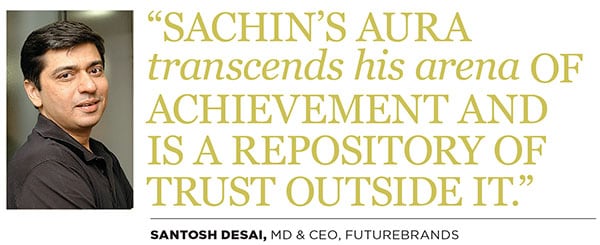
While Kohli’s on-field form since 2016 may have cast a shadow on Tendulkar’s cricketing records, the latter’s retentive aura has elevated him to the stature of a statesman who lends credibility to everything he touches. Santosh Desai, a veteran marketing professional and the MD and CEO of Futurebrands, says, “Sachin’s aura can perhaps be compared to Amitabh Bachchan’s. He isn’t there yet, but represents the same idea of someone who transcends his arena of achievement and becomes a repository of trust outside of it.” Translated to brand endorsements, it embodies a universal appeal cutting across products and target groups.
*****
With reduced proximity to the message that it represents, the value of a brand wanes over time. For Tendulkar, it would mean that his image as a world-beater would weaken with every passing year of his retirement. But, according to data from SRT Sports Management (SRTSM), the company founded by the cricketer and wife Anjali in 2016 to represent him, Tendulkar’s revenues from brand associations are estimated to rise 2.3x in 2018-19, from 2014-15, the year after he retired, despite a dip in the number of endorsements. During this period, his per brand revenue will have quadrupled.
CLICK HERE to view the 2018 Forbes India Celebrity 100 list
“Sachin as a brand will generate value for many decades. He holds so many records that every time a public discourse refers to any of these, his name will appear and earn him a few new followers,” says Arvind Sharma, ex-chairman and CEO, Leo Burnett. “However, beyond records, Sachin’s brand has been rooted in a special bond. He represented the hope of India winning as long as he was on the field. With the Indian team routinely winning in all formats, this bond has been losing its special meaning. If his revenues are going up, I would credit this to smarter management strategies to plug revenue leakage rather than to improving brand equity.”
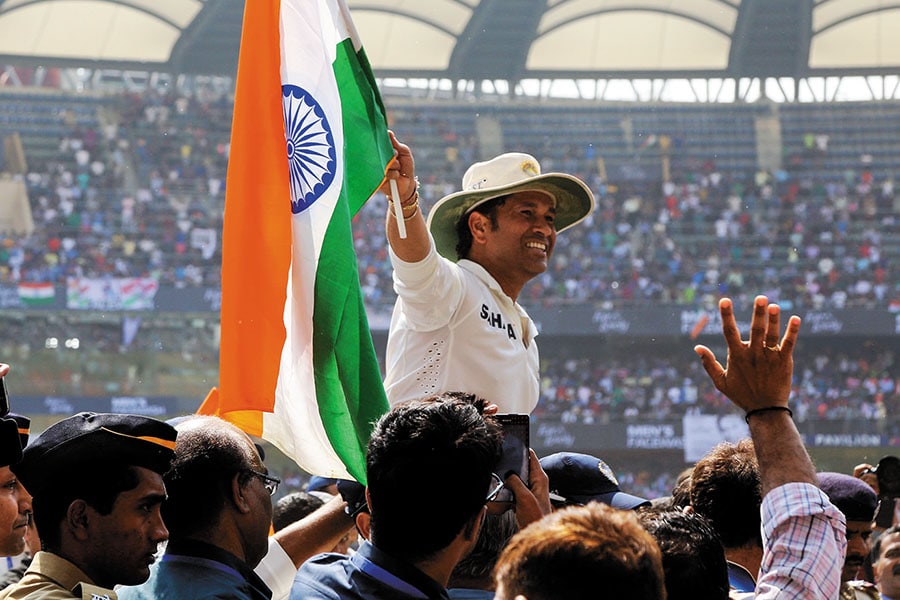 Sachin Tendulkar retired from international cricket in 2013 after playing a record 200 Tests; Image: Fotocorp
Sachin Tendulkar retired from international cricket in 2013 after playing a record 200 Tests; Image: Fotocorp
If it is indeed astute management at play, Tendulkar can feel vindicated about setting up SRTSM, bringing together seasoned managers to chart the growth trajectory of his second innings. At a time when he could have continued to be represented by an external agency, he decided to start his own company to transform ‘Brand Sachin’ into ‘Enterprise Sachin’. “While I was playing, I never focussed on anything else. Now that I have some more time, I want to have my own organisation that would reflect my values,” he says.
While the easy part was doing the maths of whether to pay a percentage of his income as commission to an agency or channel it towards SRTSM, the tough question was: How do you enhance the value of a brand that is already larger than life? Mrinmoy Mukherjee, a marketing professional with over two decades of experience, was thrown the challenge as he came on board as director and CEO. “Commercially, if you just look at endorsements, you can lock brands for two-, three- or five-year periods. They are finite in nature. If you can create value through building businesses and brands, and ensure cash flows through equity, joint ventures and royalty, you can sustain it over a long time. Rather than look at here-and-now, we decided to explore channels of legacy-creation,” says Mukherjee. Just like basketball legend Michael Jordan did to reportedly earn over $100 million in royalties alone from Nike, nearly 15 years after his retirement.
*****
To ensure continuity between his two innings, the edifice of Tendulkar Inc had to be representative of the values he stood for on the field: Excellence and hard work, yes, but also honesty and transparency, the kind that propelled him to walk off against the West Indies in the 2011 World Cup after the umpire failed to detect an edge caught by the keeper.
World over, such soft values have been the cornerstone of commercial appeal. A case in point would be US golfer Arnold Palmer who, according to Forbes, was the second-highest earning deceased celebrity in 2017, after Michael Jackson, notching $40 million a year after his death. In a survey conducted by E-Poll in 2011, in which athletes and other high-profile individuals were ranked on 46 attributes, being sincere and trustworthy among others, Palmer scored 95, the highest for a golfer, ahead of Jack Nicklaus who won 11 majors more than him.
(This story appears in the 30 November, -0001 issue of Forbes India. To visit our Archives, click here.)




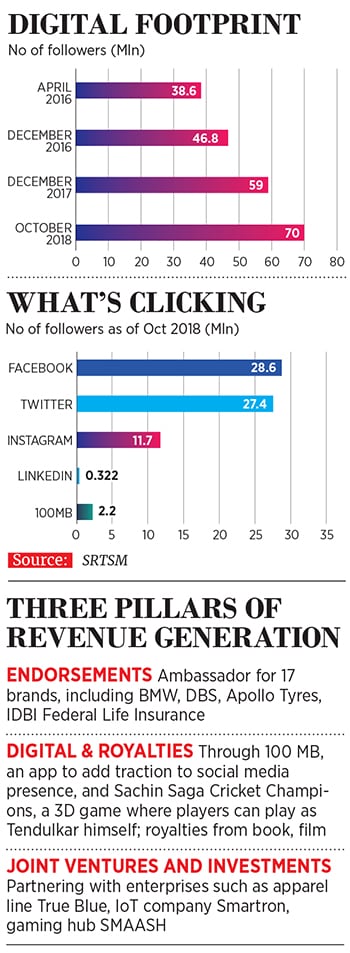
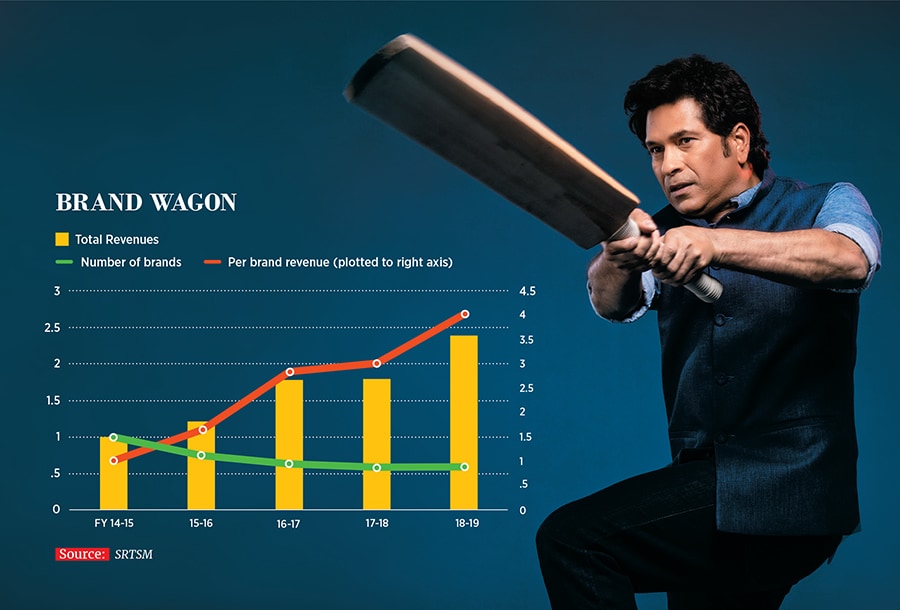
 Team SRTSM: (Standing from left) Rajyalakshmi Gummadi, VP, brand development; Mrinmoy Mukherjee, director & CEO; Zoya Kazani, manager, corporate & social initiatives; June Fernandes, head, office administration and executive secretary; Minu Vaidya, head, compliance & accounts; (Seated from left) Saurabh Saboo, VP, finance & strategy; Anjali Tendulkar, co-founder, and Sachin Tendulkar
Team SRTSM: (Standing from left) Rajyalakshmi Gummadi, VP, brand development; Mrinmoy Mukherjee, director & CEO; Zoya Kazani, manager, corporate & social initiatives; June Fernandes, head, office administration and executive secretary; Minu Vaidya, head, compliance & accounts; (Seated from left) Saurabh Saboo, VP, finance & strategy; Anjali Tendulkar, co-founder, and Sachin Tendulkar 



